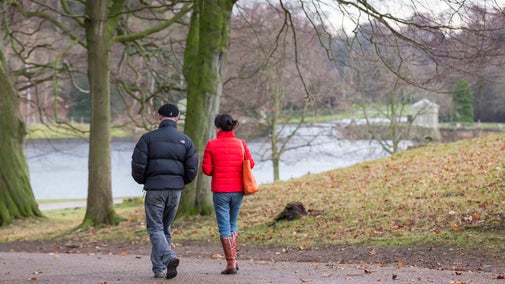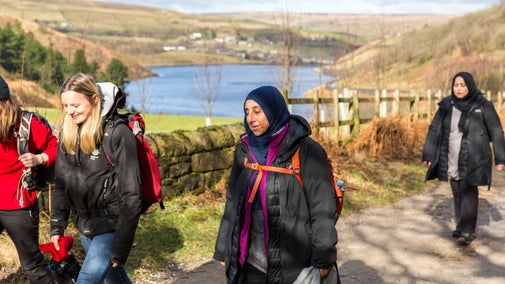Fountains Abbey ancient trees walk

On this circular walk you'll learn a little more about the ancient trees in the Deer Park and gain insights into 18th-century landscaping.
Deer park
There are three types of deer in the park: sika, fallow and red. Please keep your distance so you don't disturb them and keep dogs on a short lead.
Total stages: 7
Total stages: 7
Start point
Fountains Abbey visitor centre, grid ref: SE272687
Stage 1
Leave the visitor centre and follow signs towards St Mary's Church. Follow the signs for 'Footpath to St Mary's Church, Deer Park and Water Garden'.
Stage 2
Follow the well-defined bridlepath that runs parallel to the main drive, until you reach the large gates on your right that give access to St Mary's Church and the Deer Park. Go through the pedestrian gate, and proceed down the roadway. The sweet chestnut (A) will be on your right. Opposite St Mary's Church (a William Burges masterpiece) the impressive sweet chestnut tree is a pre-18th-century pollard. Note the line of five limes opposite Choristers House. Continue down the roadway and notice Lime Avenue (B) framing the view to Ripon Cathedral.
Stage 3
Further down the road, take the left turn at a small crossroads. Just before the brow of the hill note the ancient cherry tree (C) on your right. It is at least 325 years old and is one of the oldest cherry trees in Britain. A little further on note the impressive pre-18th-century oak tree (D), also on your right. Pass the converted stable block on your left and look straight ahead to the oak avenue (E). Look beyond the gate to the estate and see the line of oaks continue north to Low Lindrick, originally part of the estate. Continue for about 55yd (50m) then take the grass track that veers off to the right.
Stage 4
Before the beech tree look across to your left to the old sycamore pollards near the small, square pump house (F). Follow the path down a slight slope and cross the stone bridge at the bottom, known as 'Rough Bridge'. The track splits into two – take the right-hand path, going up a slight incline, and follow it as it bends to the left and continues between two lines of oak trees (G). Continue following the path as it dips. As it rises again look to your right at two Atlantic cedars (H): the result of 19th-century planting by Earl De Grey, owner of the estate from 1845 to 1859. The path bends sharply to the right, follow it to the right.
Stage 5
Continue towards the lodges at East Gate and at the bottom of Lime Avenue (B) turn right, being careful of the traffic on the road. This is the original 18th-century entrance to the estate. Just before the car park sign turn left and walk across the park to enjoy a magnificent view of the lake. Leave the viewing point and head towards the tea-room on the far side of the lake.

Stage 6
Take the roadway up to the lower car park on your right. Cross the car park, heading for a grassy path at the rear, signposted 'St Mary's Church 500yds, Visitor Centre 1 mile'. The path rises and goes through trees, bending to the right.
Stage 7
At the crest of the hill head for the old sweet chestnut (A); take a rest on the bench made from branches of the adjacent sweet chestnut. A little further the path splits into two, take the left hand path heading to the main gates of the deer park. Go through the pedestrian gate and turn sharp left to follow the footpath back to the visitor centre and main car park.
End point
Fountains Abbey visitor centre, grid ref: SE272687
Trail map

More near here

Fountains Abbey and Studley Royal Water Garden
Ancient abbey ruins and an awe-inspiring water garden at this World Heritage Site

Ripon to Fountains Abbey walk
Walk to Fountains Abbey and Studley Royal from Ripon, taking in cathedral views from the lime avenue through the deer park, then explore the Seven Bridges Valley on your return.

Fountains Abbey Estate Boundary walk
See all the highlights of Fountains Abbey and Studley Royal on a circular walk, taking in the Abbey ruins, hall, deer park and 18th-century water garden.

The Seven Bridges Valley walk
On this circular walk, you'll cross delightful arched bridges as you follow the meandering Skell river.
Get in touch
Our partners

We’ve partnered with Cotswold Outdoor to help everyone make the most of their time outdoors in the places we care for.
You might also be interested in

Walking
Explore some of the finest landscapes in our care on coastal paths, accessible trails, woodland walks and everything in between. Find the best places to walk near you.

Walking in Yorkshire
Discover some of the best walks in Yorkshire, from rugged Pennine beauty spots, views over the coast, to parkland and meadows perfect for a family stroll. Most are dog friendly and many can be enjoyed as part of your day out to the nearest National Trust property.

Cotswold Outdoor: our exclusive walking partner
Learn about the National Trust’s ongoing partnership with Cotswold Outdoor. Find out how they help us care for precious places and the exclusive discount available for National Trust supporters.

Staying safe at National Trust places
The special places in National Trust care sometimes come with a few risks for visitors, be it coastline or countryside. Find out how to keep safe throughout your visits.

Follow the Countryside Code
Help to look after National Trust places by observing a few simple guidelines during your visit and following the Countryside Code.

Eating and shopping at Fountains Abbey
Break up your adventures at Fountains Abbey and Studley Royal with some tasty refreshments. Afterwards, look for the perfect gift or a treat for yourself in the National Trust shop and plant centre.

Visiting Fountains Abbey & Studley Royal with your dog
Fountains Abbey is a three pawprint rated place. Discover why it's such a great place to bring your dog and take a look at our top tips to help you make the most of your visit.

Things to do at Studley Royal
The evocative ruins of the abbey are set beside the grounds of Studley Royal, a medieval deer park in Yorkshire. It was declared Yorkshire’s first World Heritage Site in 1986.